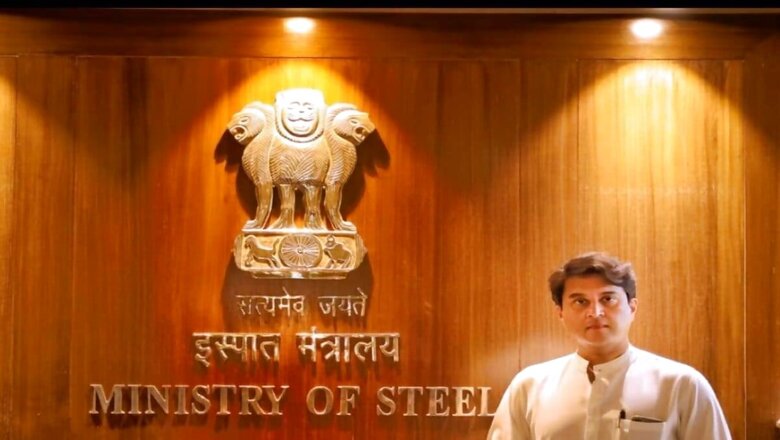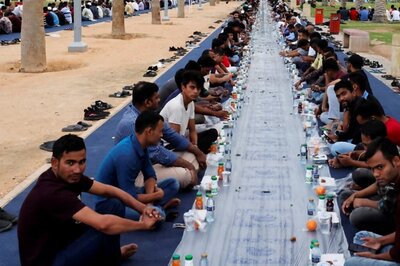
views
Scindias and the steel industry of India have had several connections. When it comes to the discovery of ancient steel in India, Madho Rao Scindia, a successor of the esteemed Mahadji Scindia (who was regarded by the Marathas as their national hero according to Surendra Nath Roy), played an important role. In 1913, as the erstwhile Maharaja of Gwalior, he made a distinct contribution to Indian archaeology by establishing a dedicated department to explore and preserve precious relics of ancient art, architecture, and culture in his state.
The archaeological department established by Scindia did several excavations. An important discovery resulting from these excavations consisted of some metal wedges used at the bottom of the Garuda pillar of Heliodoros in Vidisha. A specimen of this metal was analysed by Sir Robert Hatfield, a British metallurgist who developed manganese steel, which was found to be teal steel, proving that India knew the process of steelmaking as early as the 2nd century B.C.
In India, until the 19th century, swords, and daggers of wootz steel were made at Gwalior. Gwalior was an important city in Scindias’ kingdom and later the capital of their state from 1810 till 1947. As per Prof. Priya Satia, by 1785, Scindia had established ordnance factories in the Agra area, using indigenous technology and expertise. Maratha military culture derived from this elaborate “military economy”, including skilled metalsmiths who might as easily craft temple ornaments as cast artillery. Scindia also had high-quality flintlocks made locally, in which ignition came from a blow of flint against steel. The development of the Scindia State Railway created a huge demand for steel in central India then, from steel sleepers and tracks to locomotives. It was on November 5, 1951, that the Central Railway was formed by integrating Nizam State, Scindia State and Dholpur State Railways with GIP Railway.
Early Steps
Scindias played an important role in the starting of steel manufacturing by Tata Iron and Steel Company and even saved the company in times of crisis. Dorabji Tata, who is popular in history for having established Tata Iron and Steel Company in 1907, stationed himself in London, meeting investors, bankers, and anyone willing to listen to his story. He got a lot of encouraging words but no money. Axel Sahlin, in a lecture delivered to the Staffordshire Iron and Steel Institute in 1912, mentioned how Scindias helped the Tata Iron and Steel Company – “an issue of Debentures was decided upon to provide working capital, the entire issue, £400,000, was subscribed for by one Indian magnate, the Maharaja Scindia of Gwalior.”
Maharaja Madho Rao Scindias not only helped TISCO get working capital when the company was established but also helped TISCO with a loan of Rs 10 million when it faced its worst crisis after 1922. As per Dr Srinivas Shirur, TISCO faced the worst crisis as the company increased the production capacity to 5 lakh tons while import of cheap steel was resumed by the government after the end of the First World War. Tatas were determined to protect TISCO. They made three major decisions. First, Dorabji pledged his personal fortunes to obtain a loan of Rs 10 million from the Imperial Bank of India, which otherwise the bank refused to clear. Secondly, an additional loan of Rs 10 million was raised from the princely state of Gwalior (Maharaja Madho Rao Scindia was the ruler) through the good offices of F. E. Dinshaw, financial advisor of Maharaja Madho Rao Scindia. Thirdly, Tatas tried to secure protection for the steel industry. From this, we can understand the important role played by the maker of modern Gwalior, Maharaja Madho Rao Scindia in the development of the indigenous steel industry in India. TISCO went on to become a very successful company and was running the largest steel mill in the entire British Empire by 1939.
As Minister of Steel
On July 7, 2022, the descendant of Mahadji and Madho Rao, Jyotiraditya M. Scindia took over the charge of the Steel Ministry in India, and in that year itself, he launched the country’s first green steel brand ‘Kalyani Ferresta’ in New Delhi. For those wondering what green steel is, the author would like to explain that when steel is manufactured without using fossil fuels, it is known as green steel. It is manufactured using low-carbon energy sources like hydrogen, electricity, or coal gasification instead of the traditional carbon-intensive manufacturing route.
Under the chairmanship of Scindia, two advisory groups have been constituted namely the Advisory Group of the Ministry of Steel for Integrated Steel Plants (ISPs) and Secondary Steel Industry (SSI). Under the overall leadership of PM Modi, Scindia has introduced Made In India labelling in India’s steel industry. Scindia said, “It is the first-ever initiative by any ministry to introduce labelling and branding of the sector’s products. The Ministry of Steel is the first ministry to come up with such a branding exercise, where a single brand identity for Indian-made steel will represent India’s strong manufacturing potential.”
India, at the 26th session of the United Nations Framework Convention on Climate Change (COP26) in November 2021, announced its target to achieve net zero emissions by 2070. Scindia has shown his commitment to a greener future for India’s steel industry. At the India Steel 2023 Conference, he said, “We are taking appropriate steps to make the steel sector greener and more sustainable. The government believes in zero-waste, zero-harm policy and gradual decarbonisation is essential for our sector.”
On March 4, 2024, Jyotiraditya M Scindia launched India’s first green hydrogen plant established by Jindal Stainless in partnership with Hygenco. This project involves a state-of-the-art green hydrogen facility with a target to reduce carbon emissions by 2,700 MTPA and 54,000 tons of CO2 emissions over a period of 20 years. This will prove to be a significant step towards achieving India’s net zero emissions targets. The saga of Scindias and the steel industry is centuries old but is still continuing in contemporary India.
Conclusion
Under the able leadership of Prime Minister Narendra Modi, his team members are working very hard indeed to excel in their fields of work and in turn are contributing significantly to the development of India and the welfare of common Indians, Jyotiraditya M Scindia being one amongst them. Scindia today heads two ministries that have had strong connections with his family. It appears that these connections are serving as catalysts for him to work even harder and take his ministries to greater heights.
The author is an Advocate in the Supreme Court of India, Historian and Head, Scindia Research Centre, Scindia Palace Gwalior. Views expressed in the above piece are personal and solely that of the author. They do not necessarily reflect News18’s views.




















Comments
0 comment